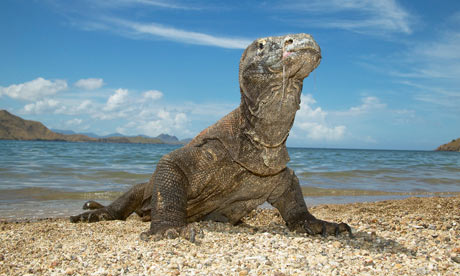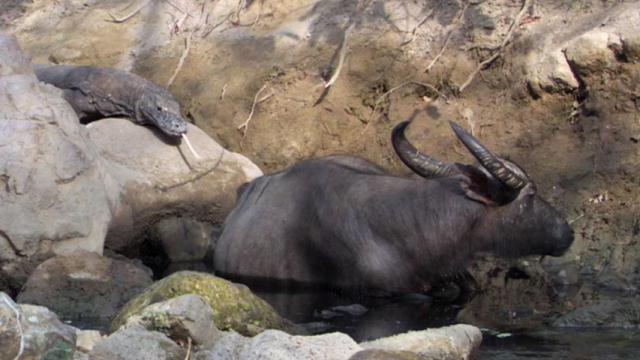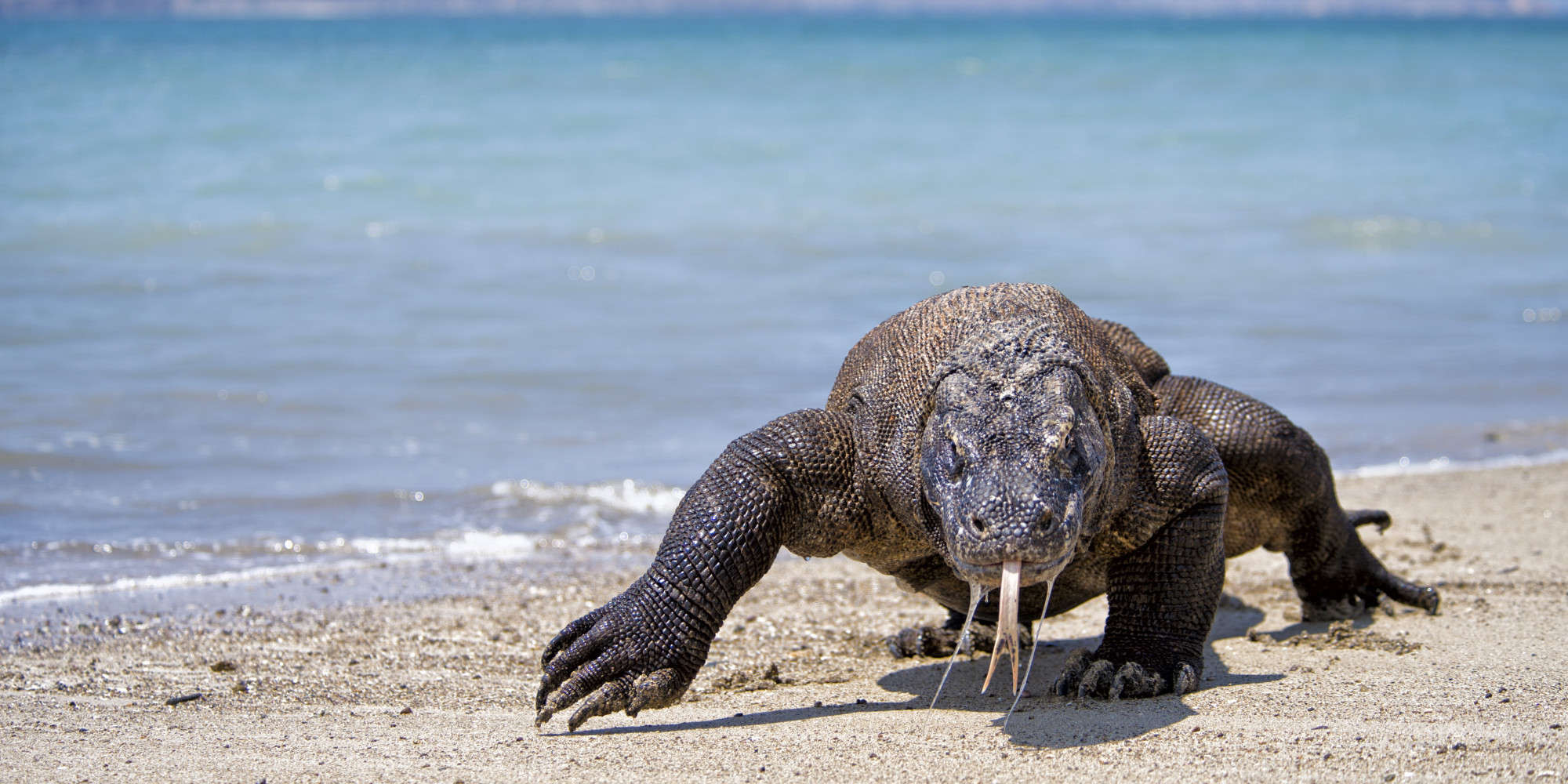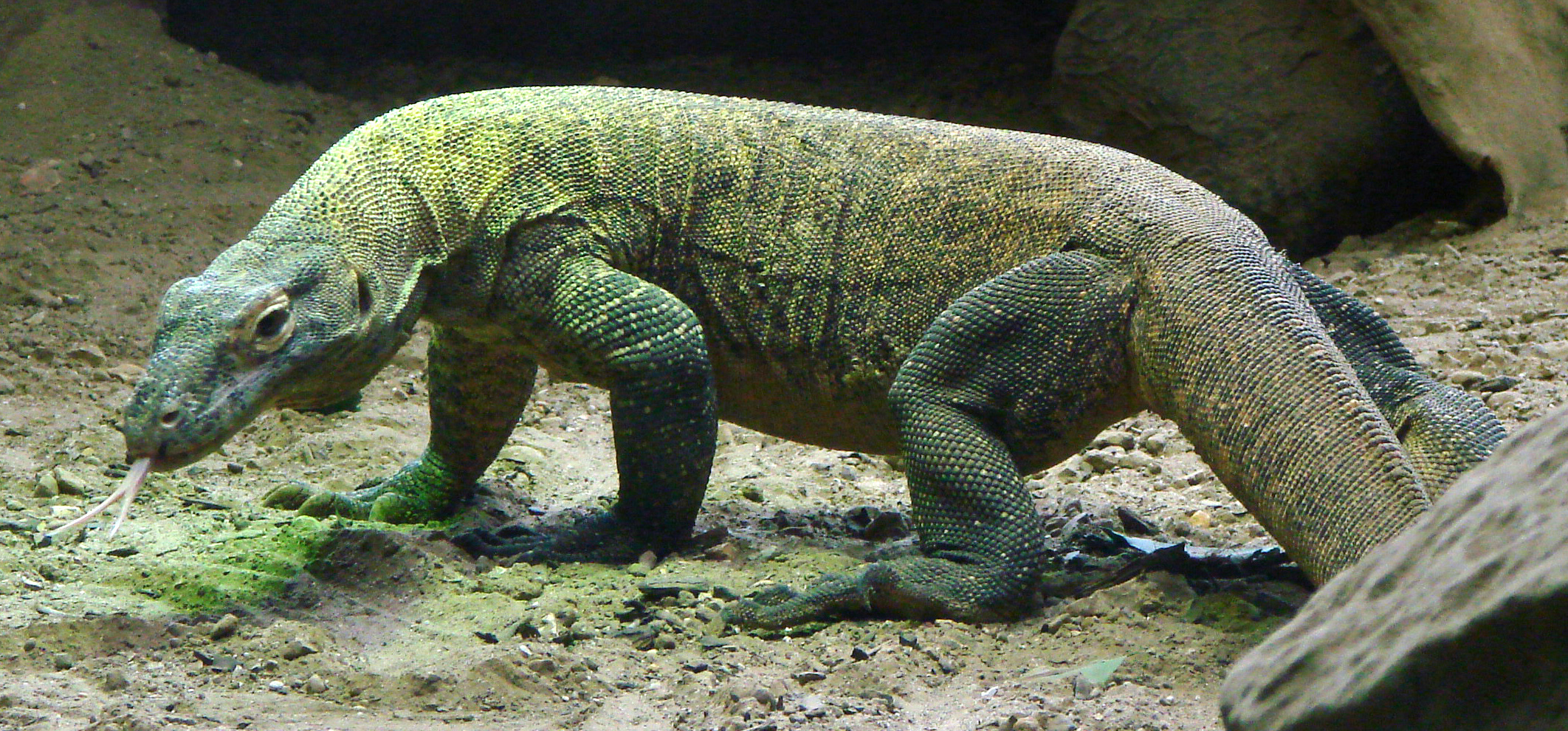HEWAN SANGAT LANGKA DAN HAMPIR PUNAH DI INDONESIA - KOMODO
Komodo Dragon

Taxonomy
Order: Squamata
Family: Varanidae
Genus/species: Varanus komodoensis
Family: Varanidae
Genus/species: Varanus komodoensis

In 1992, Komodo dragons hatched for the
first time outside of Indonesia at the National Zoo. Four clutches have hatched
and the resulting 55 offspring may be seen in more than 30 zoos around the
world. The Zoo's Komodo dragon can be seen in the outdoor enclosure behind the
Reptile Discovery Center.

Description:
The Komodo dragon is the largest living lizard. The largest verified
specimen reached a length of 10.3 feet (3.13 m) and weighed 366 pounds (166
kg). This may have included a substantial amount of undigested food. More
typical weights for the largest wild dragons are about 154 pounds (70 kg).
Although the Komodo can run briefly at speeds up to 13 mph (20 kph), its
hunting strategy is based on stealth and power. They can spend hours in one
spot, waiting for a deer, boar, goat, or anything sizable and nutritious.

Monitors can see objects as far away as
985 feet (300 m), so vision does play a role in hunting, especially as their
eyes are better at picking up movement than at discerning stationary objects.
Their retinas possess only cones, so they may be able to distinguish color but
have poor vision in dim light. They have a much smaller hearing range than
humans. The result is an animal that can not hear such sounds as a low-pitched
voice or a high-pitched scream.

Vision and hearing are useful, but the
Komodo's sense of smell is its primary food detector. The Komodo detects odors
much like a snake does. It uses its long, yellow forked tongue to sample the
air, after which the two tongue tips retreat to the roof of the mouth, where
they make contact with the Jacobson's organs. The chemical analyzers
"smell" a deer by recognizing airborne molecules. If the
concentration present on the left tongue tip is higher than that sampled from
the right, it tells the Komodo that the deer is approaching from the left. This
system, along with an undulatory walk in which the head swings from side to
side, helps the dragon sense the existence and direction of odoriferous carrion
from as far away as 2.5 miles (four km), when the wind is right.

When the Komodo is hunting and catches its
prey, a deer for example, it attacks the feet first, knocking the deer off
balance. When dealing with smaller prey, it may lunge straight for the neck.
The dragon’s basic strategy is simple: try to smash the quarry to the ground
and tear it to pieces. Strong muscles driving powerful claws accomplish some of
this, but the Komodo's teeth are its most dangerous weapon. They are large,
curved, and serrated, and tear flesh efficiently. If the deer fails to escape
immediately, the Komodo will continue to rip it apart. Once convinced that its
prey is incapacitated, the dragon may break off its offensive for a brief rest.
The deer is now badly injured and in shock. The dragon then launches the final
blow, a belly attack. The deer quickly bleeds to death, and the Komodo begins
to feed.

In 2009, researchers concluded that Komodo
dragons produce venom whose toxins cause the prey animal to go into shock and
decrease its blood from clotting. Biologists had believed that bacteria in the
dragon's mouth infected the bitten animal and caused its death. Scientists had
found some 50 different bacterial strains, at least seven of which are highly
septic, in the saliva. If a bitten deer somehow maneuvers away and escapes
immediate death, chances are that its victory, and it, will be short-lived. The
venom from the Komodo bite will probably kill it within one week; its attacker,
or more likely other Komodos, will then consume it, usually as a group.

The
Komodo bite is not deadly to another Komodo, however. Dragons wounded in battle
with their comrades appear to be unaffected by the otherwise deadly venom.
Scientists are searching for antibodies in Komodo blood that may be responsible
for saving them from the fate of the infected deer.
The muscles of the Komodo's jaws and
throat allow it to swallow huge chunks of meat with astonishing rapidity.
Several movable joints, such as the intramandibular hinge, open the lower jaw
unusually wide. The stomach expands easily, enabling an adult to consume up to
80 percent of its own body weight in a single meal, which most likely explains
some exaggerated claims for immense weights in captured individuals. Komodos
can throw up the contents of their stomachs when threatened to reduce their
weight in order to flee.

Large mammalian carnivores, such as lions,
tend to leave 25 to 30 percent of their kill unconsumed, declining the
intestines, hide, skeleton, and hooves. Komodos eat much more efficiently,
forsaking only about 12 percent of the prey. They eat bones, hooves, and swaths
of hide. They also eat intestines, but only after swinging them vigorously to
scatter their contents. This behavior removes feces from the meal. Because
large Komodos cannibalize young ones, the young often roll in fecal material,
thereby assuming a scent that the large dragons avoid. Young dragons also
undergo rituals of appeasement, with the smaller lizards pacing around a
feeding circle in a stately ritualized walk. Their tail is stuck straight out
and they throw their body from side to side with exaggerated convulsions.

Distribution and
Habitat:
Komodo dragons are limited to a few volcanic Indonesian islands of the
Lesser Sunda group including Komodo, the largest at 22 miles (35 km) long,
Rintja, Padar, and Flores.
Komodo dragons are found in tropical
savanna forests, but range widely over the islands, from beach to ridge tops.
They escape the heat of the day and seek refuge at night in burrows that are
barely big enough for them.

Diet in the Wild:
Komodo dragons eat almost any kind of meat. They scavenge from carcasses or
stalk animals ranging in size from small rodents to large water buffalo. The
young mostly feed on small gecko lizards or insects. They are tertiary
predators (predator at the top of the food chain) and are cannibalistic. They
can detect carrion from a considerable distance, about 2.5 miles (4 km), and
actively seek it out. Komodos hunt along game trails, where they wait for prey,
deer or boar, to pass by. They then attack the prey; most are unsuccessful in
bringing down an animal. However, if the dragon was able to bite the deer the
toxic bacteria in their saliva will kill the prey within the next few days. At
that time, they can use their powerful sense of smell to locate the dead
animal. A kill is usually shared by many Komodo dragons and very little is
wasted.

Zoo Diet:
They are fed rodents, chicks, and rabbits weekly.
Reproduction:
Although males tend to grow larger and bulkier than females, no obvious
morphological differences mark the sexes. One subtle clue does exist: a slight
difference in the arrangement of scales just in front of the cloaca. Sexing
Komodos remains a challenge to researchers; the dragons themselves appear to
have little trouble figuring out who is who. With a group assembled around the
carrion, the opportunity for courtship arrives.

Most mating occurs between May and August.
Dominant males can become embroiled in ritual combat in their quest for
females. Using their tails for support, they wrestle in upright postures,
grabbing each other with their forelegs as they attempt to throw the opponent
to the ground. Blood is usually drawn, and the loser either runs or remains
prone and motionless.

The victorious wrestler initiates
courtship by flicking his tongue on a female's snout and then over her body.
The temple and the fold between the torso and the rear leg are common spots.
Stimulation is both tactile and chemical, through skin gland secretions. Before
copulation can occur, the male must evert a pair of hemipenes located within his
cloaca, at the base of the tail. The male then crawls on the back of his
partner and inserts one of the two hemipenes, depending on his position
relative to the female's tail, into her cloaca.

The female Komodo lays about 30 eggs in
September. The delay in laying may serve to help the clutch avoid the brutally
hot months of the dry season. In addition, unfertilized eggs may have a second
chance with a subsequent mating. The female lays in depressions dug on hill
slopes or within the pilfered nests of Megapode birds. These chicken-size land
dwellers make heaps of earth mixed with twigs that may reach three feet (1 m)
in height and ten feet (3 m) across. While the eggs are incubating, about nine
months, females may lie on the nests, protecting their future offspring. No
evidence exists, however, for parental care of newly hatched Komodos.

The hatchlings weigh less than 3.5 ounces
(100 g) and average only 16 inches (40 cm) in length. Their early years are
precarious, and they often fall victim to predators, including their fellow
Komodos. They feed on a diverse diet of insects, small lizards, snakes, and
birds. Should they live five years, they can weigh 55 pounds (25 kg) and
stretch 6.5 feet (2 m) long. By this time, they have moved on to bigger prey,
such as rodents, monkeys, goats, wild boars, and the most popular Komodo food,
deer. Slow growth continues throughout their lives, which may last more than 30
years.

Life Span:
Dragons may live about 30 years in the wild, but scientists are still
studying this.

Status:
Komodo dragons are endangered due in part to their limited range. It would
appear that they have been hunted (legally and illegally) over the years, but
not to the extent of decimating the population. Komodo National Park,
established in 1980, and strict anti-poaching laws have helped protect the
dragons, although illegal activity still takes place. Villagers sometimes
poison carrion bait to reduce the population, much like ranchers of the
American West poison sheep carcasses to rid the area of coyotes and mountain
lions.
Dutch colonial government instituted
protection plans as early as 1915.

Fun Fact:
The ora, or "land
crocodile" as they are called by locals, are the largest living lizards.
They can reach lengths of more than ten feet and weigh over 300 pounds. The
average size for males is eight to nine feet and about 200 pounds.

0 Response to "HEWAN SANGAT LANGKA DAN HAMPIR PUNAH DI INDONESIA - KOMODO "
Post a Comment